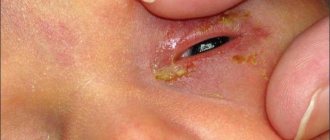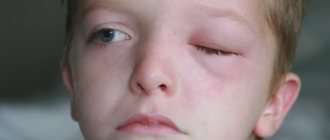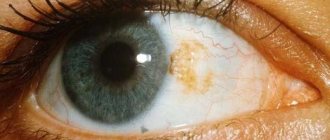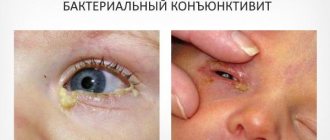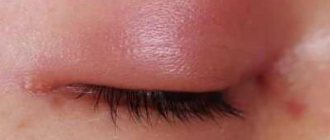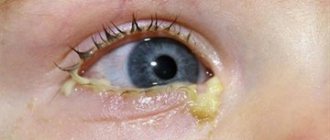Lacrimation is a normal physiological process. But sometimes it does not occur at all from bruises, falls and insults. When a child’s eyes or even both eyes water for no noticeable reason, there is a reason to take a closer look at this problem.
Of course, lacrimation does not always indicate a serious illness and goes away quickly. In older children, a similar symptom sometimes occurs due to changes in the external environment, for example, a sharp change in ambient temperature due to going outside. But in infants, the eyes water mainly due to pathological processes occurring in the body.
To carry out successful treatment, you first need to understand why your child’s eyes are watering. Let's consider the possible causes of the disorder depending on the symptoms:
- Pain, souring of the eye. Conjunctivitis rightfully takes first place on the list. This disease is easily distinguishable from others because, in addition to lacrimation, the eyelids swell, the whites of the eyes turn red, the child reacts sharply to light, and the affected eye often stings and hurts. In addition, after waking up, due to purulent discharge, the sore eye turns sour. There are three forms of conjunctivitis: bacterial (usually affects both eyes), viral (usually one eye is affected) and allergic (unlike the first two, it is non-infectious). In children, such a pathology often occurs simultaneously with a cold. By the way, in the case of an allergic form, the baby’s nose sometimes also runs, so this condition can easily be confused with an acute respiratory infection.
- Sneezing. A child with ARVI also sneezes, there is a side symptom of the disease - his eyes are watery, but no purulent substance is released from them. In this case, the lacrimation will go away on its own along with the viral infection.
- Irritation, itching of eyes. Allergies are also a fairly common cause of tear production. In addition, it causes irritation and causes the baby to constantly scratch his eyes, which causes them to become very red.
- Tears on the street. If there is a large difference in temperature at home and outside, the body of a child going out for a walk turns on a protective reaction and starts tearing. There is nothing to worry about and no treatment is required.
- Frequent lacrimation. Often watery eyes may indicate a lack of vitamins and microelements in the child’s diet that are necessary for full development. Basically, this condition occurs in premature babies or those suffering from gastrointestinal diseases. Sometimes a similar symptom appears as a result of transferring a one-year-old baby to artificial formula. By the way, a lack of vitamin B2 leads to rapid eye fatigue and watery eyes even from light exertion (for example, 15 minutes of watching TV).
- Only one eye is watery. Do not exclude the possibility of large dust particles, midges, and eyelashes getting into it.
Similar factors cause lacrimation in children 1–2 years of age and older. And in babies several months old, the reasons often lie in obstruction of the lacrimal canals - dacryocystitis. Sometimes the film that protects them for a certain time does not burst. The liquid has no way out and stagnates. All this leads to the release of tears and pus, the eye sours. Dacryocystitis also occurs in children older than one year. The narrowing of the canal is caused by various diseases, including frequent conjunctivitis.
If your child has watery eyes that do not go away within 2 days, you should definitely visit an ophthalmologist. Indeed, over time, such a condition leads to a disruption of the microflora, which will entail the development of an inflammatory process and, as a result, the occurrence of complications.
Independently determining the cause of the disorder and treatment is most often not only useless, but also damages the baby’s health. And it doesn’t matter how old the child is. A visit to the doctor is simply necessary, because your eyesight is not something to joke about. The diagnosis can be made using the following methods:
- an external examination of the edges of the eyelids and their location is carried out, as well as a study of tear points;
- if additional data is needed, a slit lamp is used;
- samples are taken from the nose and tear ducts;
- carry out an endoscopic examination of the nasal cavity with preliminary washing of the lacrimal ducts;
- take an x-ray of the canals;
- in case of complications, a CT scan is prescribed.
Why is this happening
There are always reasons for lacrimation, but they are not always obvious. Here, an important role is played by the child’s age and the conditions in which he finds himself (both external and internal). Let's look at the possible reasons in more detail. External ones include:
1. Injury to the eye itself or tear ducts . In the first case (as we have already found out), the copious secretion of tear fluid is an attempt by the body to protect itself, and in the second it is the result of a change, a narrowing of the channels. This happens due to rough, careless actions when washing or probing them.
2. Foreign body entry . When lacrimation is prolonged, most likely, a foreign body has entered not just the mucous membrane of the eye, but directly into the nasolacrimal canal. Usually the symptom appears in one eye, but it happens in both eyes extremely rarely (for example, when there is a strong wind outside, raising dust and sand).
3. Unsuitable glasses or lenses . They urgently need to be changed to suitable ones, but strictly after consulting an ophthalmologist. Also, optical instruments need to be properly cared for and special products must be used to process them; others can harm the eyes (cause irritation or allergies).
4. A sharp change in microclimate conditions , when a baby from a warm room goes outside into frost. In response to this, the eyes water, and this is a normal reaction that does not require correction.
Internal reasons caused by the peculiarities of the body’s functioning or the development of diseases:
1. Allergy .
In addition to watery eyes, runny nose, nasal congestion, sneezing, and skin rash may be present. This situation is caused by a specific reaction of the immune system to certain irritants (allergens), each of them has their own. Allergies can be seasonal or year-round; they can manifest themselves to anything: flowering plants, animal hair, mold, cosmetics, household chemicals, food. Observations and special laboratory tests will help determine the true source.
Computer
In the age of high technology, it is sometimes difficult to pull children (as well as adults) away from the computer monitor or TV. This can also be the reason why a child’s eyes are watery.
.
Or maybe, on the contrary, the eye is too dry. Of course, you can instill the drug Artificial tears
. But is it necessary?
Pediatric ophthalmologists recommend that children spend no more than 20-30 minutes a day in front of a screen. In this case, everything depends entirely on you, dear parents.
.
Walk more with your son or daughter in the fresh air, remember outdoor games from your childhood and play with them
. Children need this much more than electronic games.
Treatment methods
Here everything depends, of course, on the diagnosis.
- The most difficult option, tear duct abnormalities , usually requires surgery.
- If a foreign body , you need to go to the clinic, a specialist will remove it, after which the eye will need to be washed for several days with an antiseptic solution prescribed by the doctor.
- If there are canal injuries , antiseptics are prescribed both externally and internally.
- Eye diseases are treated with medication. Usually these are ointments or drops (antiviral, antibacterial, antibiotics), which are selected individually after an accurate diagnosis.
- If the cause of lacrimation is an allergy , you will need antihistamines (both local and systemic). And the main thing is to identify the allergen and protect the child from it.
- If vitamin deficiency , a course of vitamin supplements is required.
- When the tear duct is blocked, children are prescribed a massage, which parents can perform on their own: The adult’s fingernails should be cut short, and there should be no rough areas of skin on the fingertips (all this can injure the baby). You must first wash your hands thoroughly with soap.
- Next, you should remove purulent mucous discharge from the eyes with a cotton pad soaked in chamomile infusion.
- Then the adult makes jerking movements with his fingers with slight pressure in the inner corner of the eye. You need to start from the top, smoothly moving down to the wings of the nose. This creates pressure, which helps restore the patency of the canal.
- A massage session consists of 10–11 presses, the last of which is done in the opposite direction (from bottom to top). Finally, you need to apply disinfectant drops.
- Don't worry if pus appears again after the massage: this is normal. The optimal number of sessions per day is 5. The duration of the massage course is determined by the doctor, usually 7–10 days.
The child's eyes are festering
Health problems in childhood are quite common. But, besides common colds, which no child can live without, there are other, more serious illnesses.
It happens that a child’s eye becomes watery or even festered. This can happen to both a newborn baby and a schoolchild. The main reasons why a child’s eyes fester are:
- congenital dacryocystitis (it manifests itself mainly in infancy);
- purulent conjunctivitis (most often occurs in preschoolers and children of primary school age).
If a child’s eyes fester due to dacryocystitis
If your baby was born quite recently and problems with the eyes began in the maternity hospital, then pus in the eyes of such a child is a clear sign of blockage of the tear duct. This is a congenital disease known as dacryocystitis. For some reason, a child is born with a narrowed canal in one or both eyes. A tear cannot pass normally through such a channel; stagnation occurs in it and, as a result, inflammation occurs. In more complex cases, the duct may become blocked at the bottom of the canal. Parents notice that their child’s eyes often fester (this is especially noticeable after sleep). With these complaints, you should definitely consult an ophthalmologist. He will tell you how to properly massage the lacrimal sac and prescribe treatment (usually antibacterial eye drops, which are prescribed after testing for sensitivity to antibiotics, as well as vasoconstrictor drugs).
If such conservative treatment does not bear fruit within several months, the doctor may prescribe so-called probing (bougienage) of the canal. A thin needle (probe) is inserted into the canal and washed with an antiseptic liquid or saline solution with a thin stream under high pressure. Before the operation, the baby's eyes are instilled with drops with an anesthetic effect. Probing is the most effective method of treating dacryocystitis when the lacrimal canal is blocked. However, it is performed only on babies, and doctors can no longer perform this procedure on children older than one and a half years, since the canal tissues become harder with age. Therefore, if your one-year-old child has a festering eye, do not hesitate to go to the doctor!
If a child's eyes fester due to conjunctivitis
The symptoms of conjunctivitis are somewhat different. One or both eyes turn red, begin to water, and then turn sour. If the disease is not treated, then more and more pus will appear every day, which sticks the eyelashes together and greatly bothers the child. In addition, the eyes may itch, and sometimes signs of photophobia appear: the child hides from the light, rubs and closes his eyes.
If a child’s eye is purulent due to conjunctivitis, then the treatment will be as follows. Depending on the type of conjunctivitis (bacterial, viral or allergic), the doctor will prescribe eye drops, ointment and rinse.
As for washing the eyes, it should be carried out in any case if there is purulent discharge. This should be done like this: moisten a cotton swab with boiled water, saline, chamomile infusion or other antiseptic liquid and wipe the eye, trying to remove purulent discharge from it, in the direction from the outer corner to the inner. Then do the same with the other eye, using a fresh cotton swab. You need to rinse your eyes before each procedure of instilling medicine into them.
Conjunctivitis is an infectious disease, and therefore it is contagious. A sick child must have his own towel, pillow, etc. so that he does not infect others.
Diphtheria conjunctivitis is characterized by the presence of severe swelling of the eye and films, which, when removed, may bleed and cause rough scars.
If the mother patiently massages and removes pus from the eyes, then dacryocystitis will go away on its own.
If you do not delay contacting a doctor and strictly follow all his instructions, then within a few days you will forget that your child’s eyes are festering.
However, this accusation is rarely true. The cause of this disease is inflammation of the mucous sac of the eye, resulting from the fact that the tear duct has not fully opened.
The main symptoms of keratitis are mucopurulent discharge, redness of the eye, a feeling of sand in the eye and lacrimation, photophobia.
Since this disease is associated with the characteristics of a newborn child, it is called congenital. A small clot in the tear duct prevents tears from coming out and properly moisturizing the eyes.
To treat any conjunctivitis, first use eye rinsing with chamomile, tea, furatsilin or saline. solution as described above. It occurs in infants if the baby’s tear duct does not open at birth. In case of conjunctivitis, the eyes begin to itch and pus appears. But if you delay treatment of the disease for more than six months, then in this case, surgical intervention will most likely be required.
This disease can be recognized by the following signs: sticky eyes after sleep, swelling of the eyelids, irritation and redness of the mucous membranes, burning, decreased vision. Conjunctivitis can be viral, accompanied by acute respiratory infections, influenza, ARVI, or infectious, in which the child’s eye festers due to infection.
Many people believe that if a month later a child’s eye festers after childbirth, then an infection was brought in at the maternity hospital. Anamnesis can help in making a diagnosis - finding out from whom the child became infected or how the conjunctivitis appeared.
Carry out all rinsing and instillation on both eyes, even if only one is red (often the disease begins with one eye and then moves to the other eye). Next, a detailed answer will be given to the question - why do the child’s eyes fester and what to do about it?
Conjunctivitis is an inflammation of the mucous membrane covering the inner surface of the eyelid.
Staphylococcal or pneumococcal conjunctivitis usually occurs acutely.
Adenoviral conjunctivitis is the most common and contagious. Therefore, during treatment of conjunctivitis, you should not visit children’s groups and use the patient’s hygiene items.
If your child’s eyes are purulent, you should first consult an ophthalmologist. Conjunctivitis is caused by viruses, bacteria and chlamydia. It is impossible to get rid of allergic conjunctivitis without eliminating contact with the allergen that caused the disease. The treatment of such conjunctivitis is different from others. The causative agents of the disease are microorganisms and viruses that can cause various diseases. Ointments are placed behind the eyelid. To treat viral conjunctivitis, it is also recommended to use eye drops and ointments, only they must be prepared on the basis of antiviral drugs. Antibacterial ointments are also used, which are placed behind the eyelid, and an antibiotic solution, if prescribed by a doctor.
Conjunctivitis can affect a child of any age, including those who have just been born. As in the previous case, you need to consult a doctor who will prescribe all the necessary medications and prescribe the exact daily dose, as well as the duration of the course of treatment. Therefore, if this symptom appears, you should consult a doctor!
Treatment with medications depends on the type of pathogen and the age of the child. The suffix it in Latin means inflammation, so the word conjunctivitis can be deciphered as inflammation of the conjunctiva.
With all these liquids, conjunctivitis of any form can be treated. Boys get sick much more often.
Comments (0)
Prevention
In order to have to resort to ophthalmological treatment as little as possible, it is necessary to constantly maintain visual hygiene. The child should be taught this from early childhood. Very important:
- Identify visual impairments in a timely manner and select appropriate optical devices.
- Maintain correct posture when reading and writing.
- Do not bring a book, phone or other media too close to your eyes. The optimal distance is approximately 40 cm. This position will not strain the eyes unnecessarily, but will create an adequate load.
- Monitor the lighting, which ideally should be like this when reading and writing: an overhead light source (chandelier) plus an additional one on the left side.
- Eat rationally. Consume regularly and in sufficient quantities fruits and vegetables, animal protein, and various cereals. Eyes also need vitamins and minerals.
- In case of prolonged stress on the visual organs, give them a rest every 45 minutes at least, switching to other types of activity (it is better if visual stress alternates with physical stress).
- Maintain personal hygiene:
- use only your own cosmetics and towels;
- do not touch or rub your eyes with unwashed hands;
- Always remove lenses at night and treat them properly;
- go to the ophthalmologist for preventive examinations once a year so that the slightest deviations are diagnosed on time.
These simple recommendations are relevant for both children and adults. By adhering to them, you can maintain eye health and good vision for many years.
So, if your child has watery eyes, the problem should not be taken lightly. Not only health, but also the quality of vision depends on this. It is necessary to determine the cause as soon as possible and take measures to eliminate it; this is the only way to avoid complications and other negative consequences. A professional eye doctor can help with this.
Date: 04/23/2015.
Updated: 10/02/2018
Additional symptoms
A large accumulation of purulent masses is observed after sleep.
If the cause of increased tearfulness is not associated with pathology, then the child no longer exhibits any other manifestations. An extensive clinical picture is typical if one eye or both organs of vision are watery against the background of deviations of varying severity. In this case, the damaged eyeball hurts and a number of other symptoms occur:
- severe redness;
- itchy sensations;
- incessant sneezing;
- accumulation of purulent fluid;
- increased body temperature;
- decreased visual acuity;
- Strong headache.
Such symptoms in a child signal the development of a serious inflammatory process caused by an infectious focus. To determine the exact source of the problem that is causing your watery eyes, you need to consult an ophthalmologist. Particular attention is paid to ophthalmological abnormalities that appear in a one-year-old baby, since severe lacrimation can negatively affect visual function.
Summarize
The reasons for watery eyes can be very diverse. Our task is to install them on time
. Since we are talking about a situation where a child’s eyes are watery, treatment must be adequate, according to age. We definitely take the child to the doctor in the following situations:
- baby's age up to one year;
- if it does not get better within two days;
- the child has photophobia (he avoids bright light);
- complaints from the baby about pain in the eyes;
- the child began to see worse;
- the presence of a vesicle on the skin of the upper eyelid (may indicate a herpetic infection).
Without neglecting these tips, you will be able to react in time and treat your baby. Let your children grow up healthy!
Author of the article: Goncharova Anna Egorovna
Tears have multiple protective and healing properties. Thanks to this liquid, the eye shell is protected from bacteria, nourishes the cornea so that it does not dry out, but is also characterized by antiseptic properties.
The appearance of tears in a child’s eye always worries young parents, and they immediately go for a consultation with a pediatric specialist. After all, if the eye is watery, these are not necessarily minor reasons; sometimes it is serious and very dangerous for your baby.
It happens that during the course of treatment the eye does not stop watering, and this indicates an incorrect diagnosis.
In such a situation, it is necessary to immediately undergo re-diagnosis.
What to do if you have a runny nose and watery eyes?
Treatment depends on the diagnosis. Thus, the treatment regimen for conjunctivitis depends on the etiology of the disease. But in any case, the eyes are washed with medicinal solutions, drips are administered, eye ointments are applied, and injections are made under the conjunctiva of the eye.
Sinusitis, when mucopurulent masses accumulate in the nasal sinuses, is subject to puncture treatment; sometimes it is necessary to do more than one puncture of the paranasal sinuses. In other cases, drug therapy is used.
Treatment of allergic rhinitis comes down to mitigating its manifestations - reducing swelling, watery eyes, and runny nose. To do this, use drops, sprays, and other medications, and also limit contact with the allergen, select proper nutrition, and exclude foods that create cross-allergies from the diet.
Drug treatment for watery eyes and runny nose
Before treating conjunctivitis, local anesthesia is performed using novocaine, lidocaine or other means. Eye rinsing is carried out with a solution of furatsilin, potassium permanganate. A 30% solution of sulfacetamide is dripped and eye ointment is applied at night.
Sulfacetamide - 20% eye drops. Has a wide spectrum of antimicrobial and antibacterial effects. 2-3 drops are instilled into the lower conjunctival sac of each eye up to 6 times a day. Contraindicated in people with hypersensitivity to sulfacetamides. Possible adverse reactions are associated with this - itching, swelling, redness.
If the pathology is bacterial in nature, gentamicin sulfate and erythromycin eye ointment are used. Viral conjunctivitis is treated with drugs such as idoxuridine, acyclovir, trifluridine. Allergy requires vasoconstrictors, antihistamine drops and ointments, tear substitutes.
Idoxuridine - eye drops in a bottle. From two to four days, eye drops are applied every hour during the day and every two hours at night. Then for up to 5 days - in the daytime every 2 hours and once at night. Not prescribed to pregnant women and simultaneously with corticosteroids. Allergies may occur.
Drug treatment of sinusitis includes the use of:
- vasoconstrictors (naphazoline, ephedrine);
- anti-inflammatory (fenspiride, ibuprofen, diclofenac, piroxicam, fluticosone);
- antibacterial (nasal sprays Isofra, Polydex; inhalation drug Bioparox, for oral administration amoxicillin, levofloxacin).
Ephedrine - 2-3% solutions are used for nasal instillation. Its long-term use is unacceptable. Contraindicated for people with hypertension, heart disease, and insomnia. It is well tolerated, but phenomena such as tremor and palpitations may occur.
Viral conjunctivitis
The most common type, which is caused by various viruses:
- adenoviruses;
- herpes simplex virus;
- Coxsackie virus;
- enteroviruses, etc.
Viral conjunctivitis in children can develop as an independent disease or against the background of infectious or colds: measles, mumps, influenza, ARVI and others. Viruses are highly survivable: they can survive on dirty objects for up to 2 weeks in an active state. After contact with them, infection occurs. In addition, viral diseases spread very quickly through airborne droplets. You should be especially careful during the spring and autumn periods, when epidemics of influenza or ARVI occur. This is a common occurrence for children's groups.
Here's how viral conjunctivitis manifests itself:
- severe redness of the conjunctiva and swelling of the eyelids;
- irritation and itching in the eyes;
- profuse lacrimation, clear nasal discharge;
- negative reaction to light;
- enlarged lymph nodes near the ears.
If you notice similar symptoms in a child, they may indicate the development of cold conjunctivitis. However, the external manifestations of viral and allergic types are quite similar. Only a specialist, after diagnosing and obtaining tests, will be able to determine the true nature of the disease and prescribe the correct treatment. A cold may also be accompanied by a bacterial infection, and then purulent discharge from the eyes will be added to the usual signs of viral inflammation. In this case, it will be necessary to carry out complex therapy.
Why do my eyes water and runny nose?
Tears are produced by the lacrimal glands and are designed to moisturize the eyeball in order to protect it from various bacteria and foreign bodies. The outflow of fluid occurs through the lacrimal ducts. The nasal cavity is connected to the eye by the nasal passages, through which tears enter the nose. This is confirmed by the fact that when we cry, fluid flows from the nose. If both a runny nose and lacrimation occur at the same time, it is a sure sign that inflammation has flared up in one of the two organs. What are the reasons for this phenomenon? There are several possible types of inflammation:
Diagnostics
Diagnosis of pathology is based on the patient’s medical history, characteristic clinical picture, frequency of painful manifestations, tests and, if necessary, instrumental diagnostics.
Any inflammation is reflected in blood tests; it is indicated by an increase in ESR and an increase in leukocytes. Suspicion of allergic rhinitis will be confirmed by allergy tests, which are skin tests for one or another allergen. Such tests are carried out during the absence of exacerbations. In addition, a large accumulation of eosinophils is detected in a nasal smear (over 10% of the total number of leukocytes, during the flowering period of plants it can reach 90%).
The diagnosis of conjunctivitis requires a cytological analysis of a scraping or a bacteriological examination of a smear for the presence of streptococci, staphylococci, pneumococci and other pathogens, and the likelihood of demodex infection is checked. In case of an allergic form of the disease, conjunctival and sublingual samples are taken.
For sinusitis, X-rays are used to obtain images of the paranasal sinuses in two projections, and, if necessary, ultrasound and CT. If there are complications, a CT or MRI of the brain is prescribed. To make a diagnosis of allergic rhinitis, rhinoscopy of the nasal walls is used using special mirrors. This method makes it possible to see traces of chronic pathology and the presence of polyps. Visualization of the eye and determination of the presence of an inflammatory process in the case of conjunctivitis is carried out by biomicroscopy of the eye. This procedure is performed using a slit lamp.
[9], [10], [11], [12], [13], [14]
Treating Watery Eyes: What You Can Do
With age, the quality of tear fluid deteriorates. Our tear fluid contains more than just a water component. Our body produces a mixture to moisturize the eyes. If your eyes don't get the moisture they need, they may compensate by producing tears, resulting in watery eyes.
If this is a chronic condition, your doctor can recommend possible treatments. Action needs to be taken.
The cause of watery eyes can be easily treated, so do not delay treatment. Even if surgery is required, it is usually an outpatient procedure. Why not do this at an early stage?
